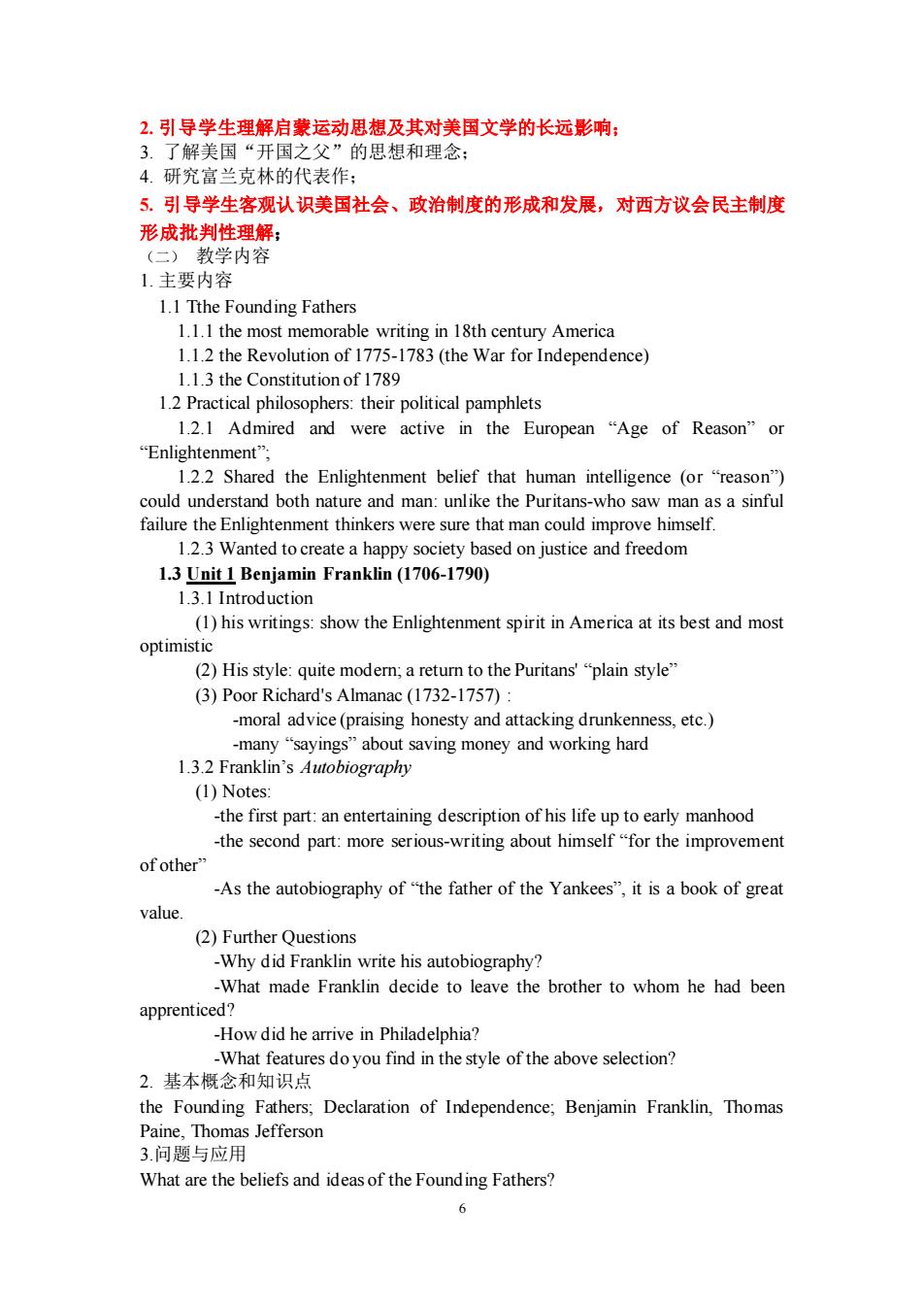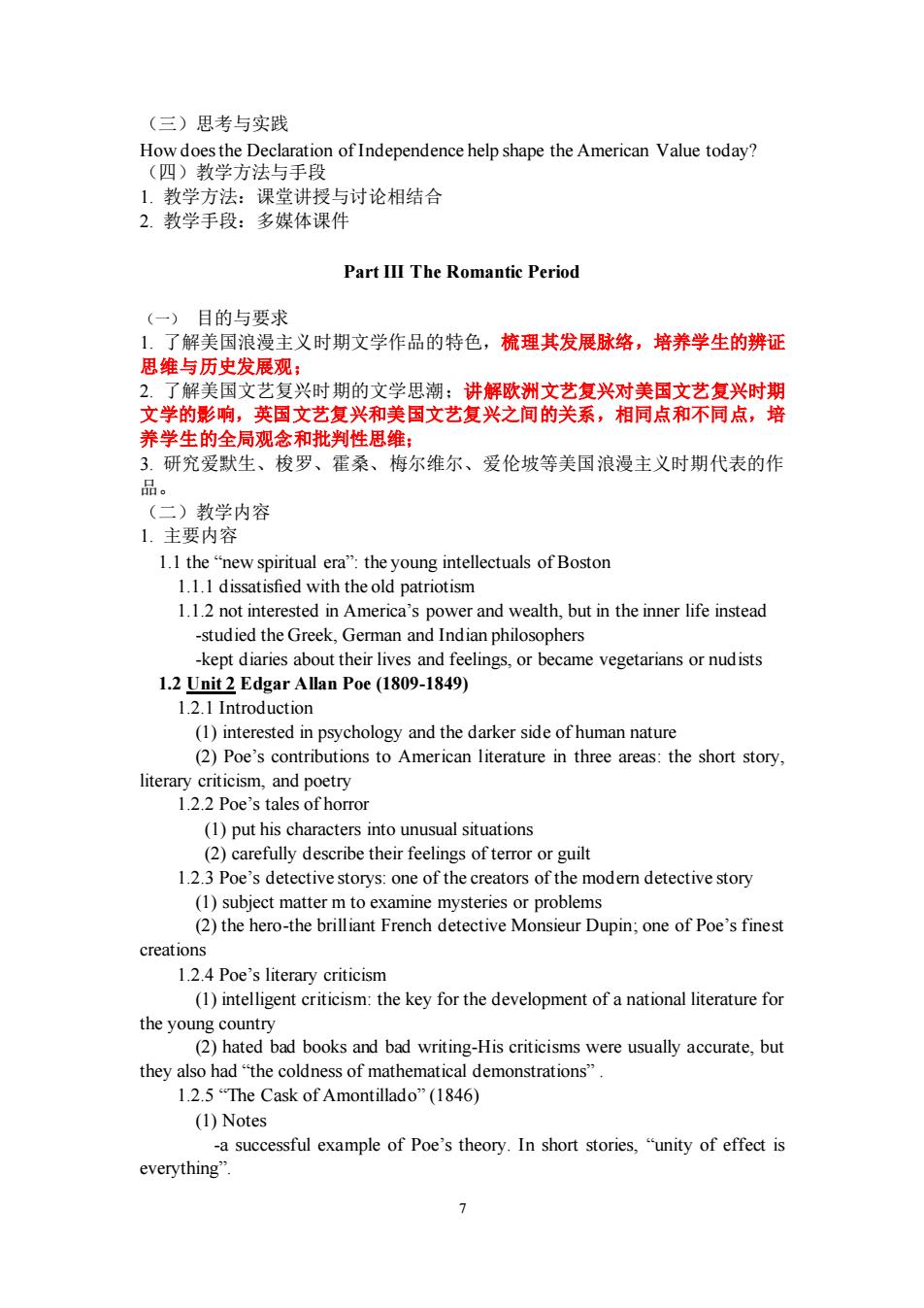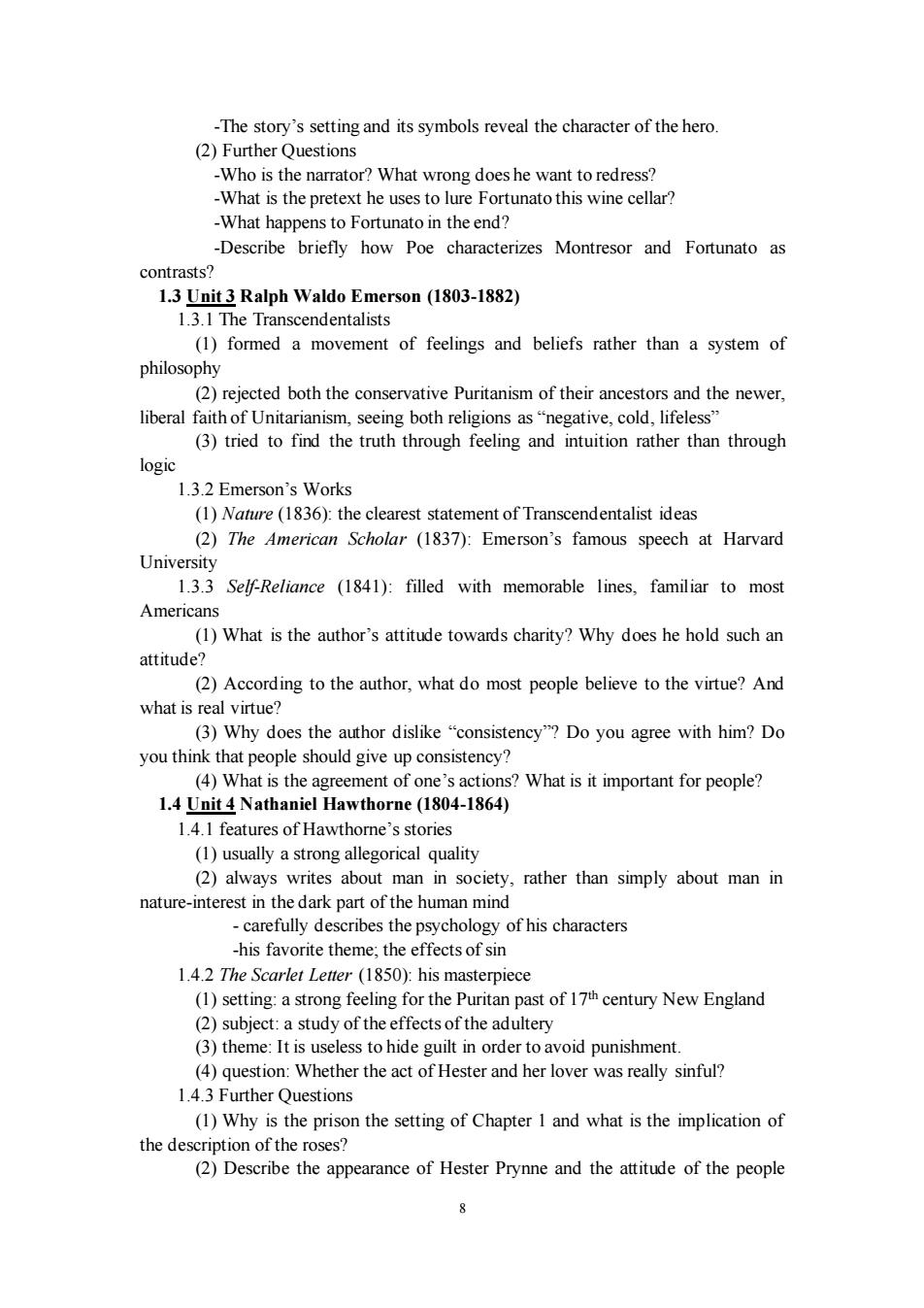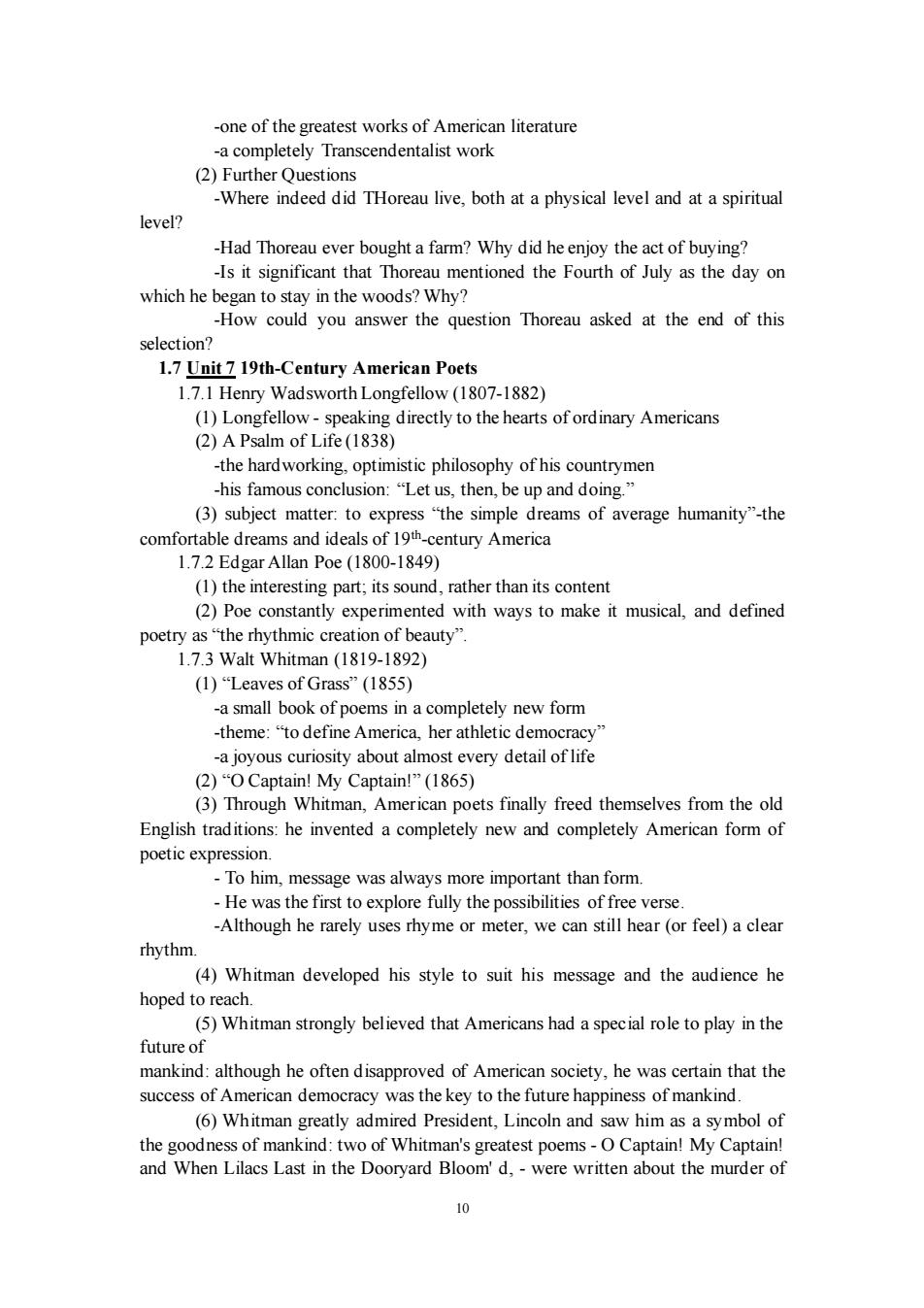
2.引导学生理解启蒙运动思想及其对美国文学的长远影响 . 了解美国 开国之父”的思想和理念: 4.研究富兰克林的代表作: 5.引导学生客观认识类国社会、政治制度的形成和发展,对西方议会民主制度 形成批判性理解: (二)教学内容 1.主要内容 1.1 Tthe Founding Fathers 1.1.1 the most memorable writing in 18th century America 1.1.2 the Revolution of 1775-1783(the War for Independence) 1.1.3 the Constitution of 1789 1.2 Practical philosophers:their political pamphlets 1.2.1 Admired and were active in the European "Age of Reason"or “Enlightenment, 1.2.2 Shared the Enlightenment belief that human intelligence (or "reason") could understand both nature and man:unlike the Puritans-who saw man as a sinful failure the Enlightenment thinkers were sure that man could improve himself. 1.2.3 Wanted to reate a happy s iety bas sed on justice nd freedom 1.3 Unit 1 Benjamin Franklin (1706-1790) 1.3.I Introduction (1)his writings:show the Enlightenment spirit in America at its best and most optimistic (2)His style:quite modem;a retum to the Puritans'plain style" (3)Poor Richard's Almanac(1732-1757) -moral advice(praising honesty and attacking drunkenness,etc.) many "sayings about saving money and working hard 1.3.2 Franklin's Autobiography (1)Notes: the first part:an entertaining description of his life uptoearly manhood -the second part:more serious-writing about himself "for the improvement of other -As the autobiography of"the father of the Yankees",it is a book of great value (②)Further Question -Why did Franklin write his autobiography? -What made Franklin decide to leave the brother to whom he had been apprenticed? -How did he arrive in philadelphia? What fea esdoyou find in the style of the above selection? 2.基本概念和知识 the Founding Fathers;Declaration of Independence;Benjamin Franklin,Thomas Paine,Thomas Jefferson 3.问题与应用 What are the beliefs and ideas of the Founding Fathers? 6
6 2. 引导学生理解启蒙运动思想及其对美国文学的长远影响; 3. 了解美国“开国之父”的思想和理念; 4. 研究富兰克林的代表作; 5. 引导学生客观认识美国社会、政治制度的形成和发展,对西方议会民主制度 形成批判性理解; (二) 教学内容 1. 主要内容 1.1 Tthe Founding Fathers 1.1.1 the most memorable writing in 18th century America 1.1.2 the Revolution of 1775-1783 (the War for Independence) 1.1.3 the Constitution of 1789 1.2 Practical philosophers: their political pamphlets 1.2.1 Admired and were active in the European “Age of Reason” or “Enlightenment”; 1.2.2 Shared the Enlightenment belief that human intelligence (or “reason”) could understand both nature and man: unlike the Puritans-who saw man as a sinful failure the Enlightenment thinkers were sure that man could improve himself. 1.2.3 Wanted to create a happy society based on justice and freedom 1.3 Unit 1 Benjamin Franklin (1706-1790) 1.3.1 Introduction (1) his writings: show the Enlightenment spirit in America at its best and most optimistic (2) His style: quite modern; a return to the Puritans' “plain style” (3) Poor Richard's Almanac (1732-1757) : -moral advice (praising honesty and attacking drunkenness, etc.) -many “sayings” about saving money and working hard 1.3.2 Franklin’s Autobiography (1) Notes: -the first part: an entertaining description of his life up to early manhood -the second part: more serious-writing about himself “for the improvement of other” -As the autobiography of “the father of the Yankees”, it is a book of great value. (2) Further Questions -Why did Franklin write his autobiography? -What made Franklin decide to leave the brother to whom he had been apprenticed? -How did he arrive in Philadelphia? -What features do you find in the style of the above selection? 2. 基本概念和知识点 the Founding Fathers; Declaration of Independence; Benjamin Franklin, Thomas Paine, Thomas Jefferson 3.问题与应用 What are the beliefs and ideas of the Founding Fathers?

(三)思考与实践 How does tion of Independence help shape the American Value today? 1.教学方法:课堂讲授与讨论相结合 2.教学手段:多媒体课件 Part III The Romantic Period (一)目的与要求 1.了解美国浪漫主义时期文学作品的特色,梳理其发展脉络,培养学生的辨证 思维与历史发展观: 2.了解美国文艺复兴时期的文学思潮:讲解欧洲文艺复兴对美国文艺复兴时期 文学的影响,英国文艺复兴和美国文艺复兴之间的关系,相同点和不同点,培 养学生的全局观念和批判性思维 3.研究爱默生、梭罗、霍桑、梅尔维尔、爱伦坡等美国浪漫主义时期代表的作 品。 (二)教学内容 1.主要内容 1.1 the"ew spiritual era"the young intellectuals of Boston 1.1.1 dissatisfied with theold patriotism 1.1 2 not interested in America's power and wealth.but in the inner life instead -studied the Greek.German and Indian philosophers -kept diaries about their lives and feelings,or became vegetarians or nudists o () (1)interested in psychology and the darker side of human nature (2)Poe's contributions to American literature in three areas:the short story, literary criticism,and poetry 12.2 Poe's tales of horror (1)put his characters into unusual situations (2)carefully describe their feelings of terror or guilt 1.2.3 Poe's detective storys:one of the creators of the modern detective story (1)subiect matter m to examine mysteries or problems (2)the hero-the brilliant French detective Monsieur Dupin;one of Poe's finest creations 1.2.4 Poe's literary criticism (1)intelligent criticism:the key for the development of a national literature for the young country (2)hated bad books and bad writing-His criticisms were usually accurate,but they also had"the coldn s of 1.2.5The Cask of Amontillado demonstrations" ”(1846 (1)Notes -a successful example of Poe's theory.In short stories,"unity of effect is everything
7 (三)思考与实践 How does the Declaration of Independence help shape the American Value today? (四)教学方法与手段 1. 教学方法:课堂讲授与讨论相结合 2. 教学手段:多媒体课件 Part III The Romantic Period (一) 目的与要求 1. 了解美国浪漫主义时期文学作品的特色,梳理其发展脉络,培养学生的辨证 思维与历史发展观; 2. 了解美国文艺复兴时期的文学思潮;讲解欧洲文艺复兴对美国文艺复兴时期 文学的影响,英国文艺复兴和美国文艺复兴之间的关系,相同点和不同点,培 养学生的全局观念和批判性思维; 3. 研究爱默生、梭罗、霍桑、梅尔维尔、爱伦坡等美国浪漫主义时期代表的作 品。 (二)教学内容 1. 主要内容 1.1 the “new spiritual era”: the young intellectuals of Boston 1.1.1 dissatisfied with the old patriotism 1.1.2 not interested in America’s power and wealth, but in the inner life instead -studied the Greek, German and Indian philosophers -kept diaries about their lives and feelings, or became vegetarians or nudists 1.2 Unit 2 Edgar Allan Poe (1809-1849) 1.2.1 Introduction (1) interested in psychology and the darker side of human nature (2) Poe’s contributions to American literature in three areas: the short story, literary criticism, and poetry 1.2.2 Poe’s tales of horror (1) put his characters into unusual situations (2) carefully describe their feelings of terror or guilt 1.2.3 Poe’s detective storys: one of the creators of the modern detective story (1) subject matter m to examine mysteries or problems (2) the hero-the brilliant French detective Monsieur Dupin; one of Poe’s finest creations 1.2.4 Poe’s literary criticism (1) intelligent criticism: the key for the development of a national literature for the young country (2) hated bad books and bad writing-His criticisms were usually accurate, but they also had “the coldness of mathematical demonstrations” . 1.2.5 “The Cask of Amontillado” (1846) (1) Notes -a successful example of Poe’s theory. In short stories, “unity of effect is everything

The its symo reveal the of (2)Further Questions -Who is the narrator?What wrong does he want to redress? -What is the pretext he uses to lure Fortunato this wine cellar? -What happens to Fortunato in the end? -Describe briefly how Poe characterizes Montresor and Fortunato as contrasts? 1.3 Unit 3 Ralph Waldo Emerson(1803-1882) 1.3.I The Transcendentalists (1)formed a movement of feelings and beliefs rather than a system of philosophy lheral of Unitarianism,secing both relgions as ngative,cold.lifeles ted both the conservative Puritanism of their ance s and the newer (3)tried to find the truth through feeling and intuition rather than through logic 1 32 Emerson's Works (1)(1836):the clearest statement of Transcendentalist ideas (2)The American Scholar(1837):Emerson's famous speech at Harvard University 1.3.3 SelfReliance (1841):filled with memorable lines.familiar to most Americans (1)What is the author's attitude towards charity?Why does he hold such an (2)According to the author,what do most people believe to the virtue?And what is real virtue? (3)Why does the author dislike "consistency"?Do you agree with him?Do you think that people should give up consistency? 1.4 Unit Nathanicl Hawthorne (1 s the as nt of one's actions?What is it important for people? 1.4.1 features of Hawthorne's stories (1 usually a strong allegorical quality (2)always writes about man in society,rather than simply about man in nature-interest in the dark part of the human mind carefully describes the of his characters his favorite theme the effects of sir 1.4.2 The Scarlet Letter (1850):his masterpiece (1)setting:a strong feeling for the Puritan past of 17th century New England (2)subiect:a study of the effects of the adultery (3)th e Itis Iseless to hide uiti n order avoid punishment (4)question:Whether the act of Hester and her lover was really sinful? 1.4.3 Further Questions (1)Why is the prison the setting of Chapter 1 and what is the implication of the description of the roses? (2)Describe the appearance of Hester Prynne and the attitude of the people
8 -The story’s setting and its symbols reveal the character of the hero. (2) Further Questions -Who is the narrator? What wrong does he want to redress? -What is the pretext he uses to lure Fortunato this wine cellar? -What happens to Fortunato in the end? -Describe briefly how Poe characterizes Montresor and Fortunato as contrasts? 1.3 Unit 3 Ralph Waldo Emerson (1803-1882) 1.3.1 The Transcendentalists (1) formed a movement of feelings and beliefs rather than a system of philosophy (2) rejected both the conservative Puritanism of their ancestors and the newer, liberal faith of Unitarianism, seeing both religions as “negative, cold, lifeless” (3) tried to find the truth through feeling and intuition rather than through logic 1.3.2 Emerson’s Works (1) Nature (1836): the clearest statement of Transcendentalist ideas (2) The American Scholar (1837): Emerson’s famous speech at Harvard University 1.3.3 Self-Reliance (1841): filled with memorable lines, familiar to most Americans (1) What is the author’s attitude towards charity? Why does he hold such an attitude? (2) According to the author, what do most people believe to the virtue? And what is real virtue? (3) Why does the author dislike “consistency”? Do you agree with him? Do you think that people should give up consistency? (4) What is the agreement of one’s actions? What is it important for people? 1.4 Unit 4 Nathaniel Hawthorne (1804-1864) 1.4.1 features of Hawthorne’s stories (1) usually a strong allegorical quality (2) always writes about man in society, rather than simply about man in nature-interest in the dark part of the human mind - carefully describes the psychology of his characters -his favorite theme; the effects of sin 1.4.2 The Scarlet Letter (1850): his masterpiece (1) setting: a strong feeling for the Puritan past of 17th century New England (2) subject: a study of the effects of the adultery (3) theme: It is useless to hide guilt in order to avoid punishment. (4) question: Whether the act of Hester and her lover was really sinful? 1.4.3 Further Questions (1) Why is the prison the setting of Chapter 1 and what is the implication of the description of the roses? (2) Describe the appearance of Hester Prynne and the attitude of the people

towardsher (3)What has happened to Heste Why does she make the embroidery of the letterAso elaborate?How doesthis tell us about her character 1.5 Unit 5 Herman Melville (1819-1891) 15.1 Introduction (1)became a sailor at age twenty m his most important experience in life (life at sea mpo rtant material for his books and short stories ories (1)more than simple sea adventures-the voyages of his heroes:searches for the truth (2)In his fiction.man lives in a world divided into two warring parts:good these opposites (3)tragic view of life:The universe itself is working against human happiness and peace of mind.The world has no place for pure goodness or pure evil. 15.3ob-Dick(1851) (1)the greatest novel of american literature (2)th (Moby-Dic of the whali equod;a symbolic k.the grea voyage e:represents God or fate (4)a great deal of factual information about whale-hunting:to make the world of Moby-Dick seem real (5)Captain Ahab.the central Character and,ungodly,God-like man" y and his desire todestroy the white whale -These two sides-the light and the dark-fight each other in Ahab -theme:Personal identity is only an illusion 1.5.4 Further Questions (1)What are the stories Ishmael tells about Moby Dick? (2)Why does Ahab act so violently nst the white whale?Ishmael suggests that Ahab is“cray”and callshim“a raving lunatic..”Do you agree with him Why or why not? (3)What narrative features can you find in the selected chapter? 1.6 Unit 6 Henry David Thoreau (1817-1862) 1.6.1 putting into practice nany of Emerson's theories;an experienced woodsman whos works are filled with details about plants,rivers and wildlife 1.6.2 Civil Disobedience (1849) (1)about his experience in jail in 1846 (2)theme:"we should be men first and subjects afterward" (3)great influence on Tolstoy,Gandhiand Martin Luther King (4)the best-knc wn Am n essay outs ide the United States 1.63 Walden1854到 (1)Notes -about his stay in the hut(1845-1847)he built for himself on the north shore of Walden Pond
9 towards her. (3) What has happened to Hester? Why does she make the embroidery of the letter A so elaborate? How does this tell us about her character? 1.5 Unit 5 Herman Melville (1819-1891) 1.5.1 Introduction (1) became a sailor at age twenty m his most important experience in life (2) life at sea—the most important material for his books and short stories 1.5.2 features of Melville’s stories (1) more than simple sea adventures -the voyages of his heroes: searches for the truth (2) In his fiction, man lives in a world divided into two warring parts: good against evil, God against Satan, the “head” against the “heart” -no way to overcome these opposites (3) tragic view of life: The universe itself is working against human happiness and peace of mind. The world has no place for pure goodness or pure evil. 1.5.3 Moby-Dick (1851) (1) the greatest novel of American literature (2) the voyage of the whaling ship Pequod; a symbolic voyage (3) Moby-Dick, the great White whale: represents God or fate (4) a great deal of factual information about whale - hunting; to make the world of Moby-Dick seem real (5) Captain Ahab, the central Character -“a grand, ungodly, God-like man” -torn between his humanity and his desire to destroy the white whale - These two sides -the light and the dark -fight each other in Ahab. - theme: Personal identity is only an illusion 1.5.4 Further Questions (1) What are the stories Ishmael tells about Moby Dick? (2) Why does Ahab react so violently against the white whale? Ishmael suggests that Ahab is “crazy” and calls him “a raving lunatic.” Do you agree with him? Why or why not? (3) What narrative features can you find in the selected chapter? 1.6 Unit 6 Henry David Thoreau (1817-1862) 1.6.1 putting into practice many of Emerson’s theories; an experienced woodsman whose works are filled with details about plants, rivers and wildlife 1.6.2 Civil Disobedience (1849) (1) about his experience in jail in 1846 (2) theme: “we should be men first and subjects afterward” (3) great influence on Tolstoy, Gandhi and Martin Luther King (4) the best-known American essay outside the United States 1.6.3 Walden (1854) (1) Notes -about his stay in the hut (1845-1847) he built for himself on the north shore of Walden Pond

(2)Further Questions -Where indeed did THoreau live.both at a physical level and at a spiritual level? -Had Thoreau ever bought a farm?Why did he enjoy the act of buying? Is it significa which he began to stay in the woods?Why? -How could you answer the question Thoreau asked at the end of this selection? 1.7 Unit 7 19th-Century American Poets 1.7.1 Henry Wadsworth Longfellow(1807-1882) speaking directly to the hearts of ordinary Americans (2)A Psalm of Life(1838) -the hard working.optimistic philosophy of his countrymen -his famous conclusion:"Let us,then,be up and doing." (3)subject matter.to express"the simple dreams of average humanity"-the comfor and ideals of1 century America (1)the interesting part;its sound,rather than its content (2)Poe constantly experimented with ways to make it musical,and defined poetry as"the rhythmic creation of beauty" 1.7.3 Walt Whitman(1819-1892) ()Leaves of Grass”(1855 -a small book of poems in a completely new form -theme:"to define America,her athletic democracy" -a joyous curiosity about almost every detail of life (2)Captain!My Captain!"(185) (3)Through Whitman American p oets finally freed themselves from the old English traditions:he invented a completely new and completely American form of poetic expression. -To him.message was always more important than form -He was the first to explore fully the possibilities of free verse -Altho r,we can still hear (or feel)a clear rhythm (4)Whitman developed his style to suit his message and the audience he hoped to reach. (5)Whitman strongly believed that Americans had a special role to play in the future of mankind:although he often disapproved of American society,he was certain that the success of American democracy was the key to the future happiness of mankind. (6)Whitman greatly admired President,Lincoln and saw him as a symbol of the goodness of mankind:two of Whitman's greatest poems-O Captain!My Captain! and When Lilacs Last in the Dooryard Bloom'd.-were written about the murder of 10
10 -one of the greatest works of American literature -a completely Transcendentalist work (2) Further Questions -Where indeed did THoreau live, both at a physical level and at a spiritual level? -Had Thoreau ever bought a farm? Why did he enjoy the act of buying? -Is it significant that Thoreau mentioned the Fourth of July as the day on which he began to stay in the woods? Why? -How could you answer the question Thoreau asked at the end of this selection? 1.7 Unit 7 19th-Century American Poets 1.7.1 Henry Wadsworth Longfellow (1807-1882) (1) Longfellow - speaking directly to the hearts of ordinary Americans (2) A Psalm of Life (1838) -the hardworking, optimistic philosophy of his countrymen -his famous conclusion: “Let us, then, be up and doing.” (3) subject matter: to express “the simple dreams of average humanity”-the comfortable dreams and ideals of 19th -century America 1.7.2 Edgar Allan Poe (1800-1849) (1) the interesting part; its sound, rather than its content (2) Poe constantly experimented with ways to make it musical, and defined poetry as “the rhythmic creation of beauty”. 1.7.3 Walt Whitman (1819-1892) (1) “Leaves of Grass” (1855) -a small book of poems in a completely new form -theme: “to define America, her athletic democracy” -a joyous curiosity about almost every detail of life (2) “O Captain! My Captain!” (1865) (3) Through Whitman, American poets finally freed themselves from the old English traditions: he invented a completely new and completely American form of poetic expression. - To him, message was always more important than form. - He was the first to explore fully the possibilities of free verse. -Although he rarely uses rhyme or meter, we can still hear (or feel) a clear rhythm. (4) Whitman developed his style to suit his message and the audience he hoped to reach. (5) Whitman strongly believed that Americans had a special role to play in the future of mankind: although he often disapproved of American society, he was certain that the success of American democracy was the key to the future happiness of mankind. (6) Whitman greatly admired President, Lincoln and saw him as a symbol of the goodness of mankind: two of Whitman's greatest poems - O Captain! My Captain! and When Lilacs Last in the Dooryard Bloom' d, - were written about the murder of